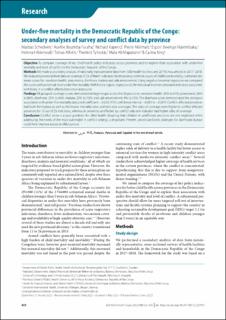| dc.contributor.author | Schedwin, Mattias | |
| dc.contributor.author | Furaha, Aurélie Bisumba | |
| dc.contributor.author | Kapend, Richard | |
| dc.contributor.author | Akilimali, Pierre | |
| dc.contributor.author | Malembaka, Espoir Bwenge | |
| dc.contributor.author | Hildenwall, Helena | |
| dc.contributor.author | Alfvén, Tobias | |
| dc.contributor.author | Tylleskär, Thorkild | |
| dc.contributor.author | Mapatano, Mala Ali | |
| dc.contributor.author | King, Carina | |
| dc.date.accessioned | 2022-12-29T10:43:31Z | |
| dc.date.available | 2022-12-29T10:43:31Z | |
| dc.date.created | 2022-08-17T10:27:10Z | |
| dc.date.issued | 2022 | |
| dc.identifier.issn | 0042-9686 | |
| dc.identifier.uri | https://hdl.handle.net/11250/3039828 | |
| dc.description.abstract | Objective
To compare coverage of key child health policy indicators across provinces and to explore their association with under-five mortality and level of conflict in the Democratic Republic of the Congo.
Methods
We made a secondary analysis of nationally representative data from 1380 health facilities and 20 792 households in 2017–2018. We analysed provincial-level data on coverage of 23 different indicators for improving common causes of childhood mortality, combined into mean scores for: newborn health, pneumonia, diarrhoea, malaria and safe environment. Using negative binomial regression we compared the scores with provincial-level under-five mortality. With binary logistic regression at the individual level we compared indicators (outcome) with living in a conflict-affected province (exposure).
Findings
All grouped coverage scores demonstrated large ranges across the 26 provinces: newborn health: 20% to 61%; pneumonia: 26% to 86%; diarrhoea: 25% to 63%; malaria: 22% to 53%; and safe environment: 4% to 53%. The diarrhoea score demonstrated the strongest association with under-five mortality (adjusted coefficient: −0.026; 95% confidence interval: −0.045 to −0.007). Conflict-affected provinces had both the highest as well as the lowest mortality rates and indicator coverages. The odds of coverage were higher in conflict-affected provinces for 13 out of 23 indicators, whereas in provinces unaffected by conflict only one indicator had higher odds of coverage.
Conclusion
Conflict alone is a poor predictor for child health. Ensuring that children in unaffected provinces are not neglected while addressing the needs of the most vulnerable in conflict settings is important. Prevent, protect and treat strategies for diarrhoeal disease could help improve equity in child survival. | en_US |
| dc.language.iso | eng | en_US |
| dc.publisher | World Health Organization | en_US |
| dc.rights | Navngivelse 4.0 Internasjonal | * |
| dc.rights.uri | http://creativecommons.org/licenses/by/4.0/deed.no | * |
| dc.title | Under-five mortality in the Democratic Republic of the Congo: secondary analyses of survey and conflict data by province | en_US |
| dc.type | Journal article | en_US |
| dc.type | Peer reviewed | en_US |
| dc.description.version | publishedVersion | en_US |
| cristin.ispublished | true | |
| cristin.fulltext | original | |
| cristin.qualitycode | 2 | |
| dc.identifier.doi | 10.2471/BLT.22.287915 | |
| dc.identifier.cristin | 2043724 | |
| dc.source.journal | Bulletin of the World Health Organization | en_US |
| dc.source.pagenumber | 422-435 | en_US |
| dc.identifier.citation | Bulletin of the World Health Organization. 2022, 100 (7), 422-435. | en_US |
| dc.source.volume | 100 | en_US |
| dc.source.issue | 7 | en_US |

